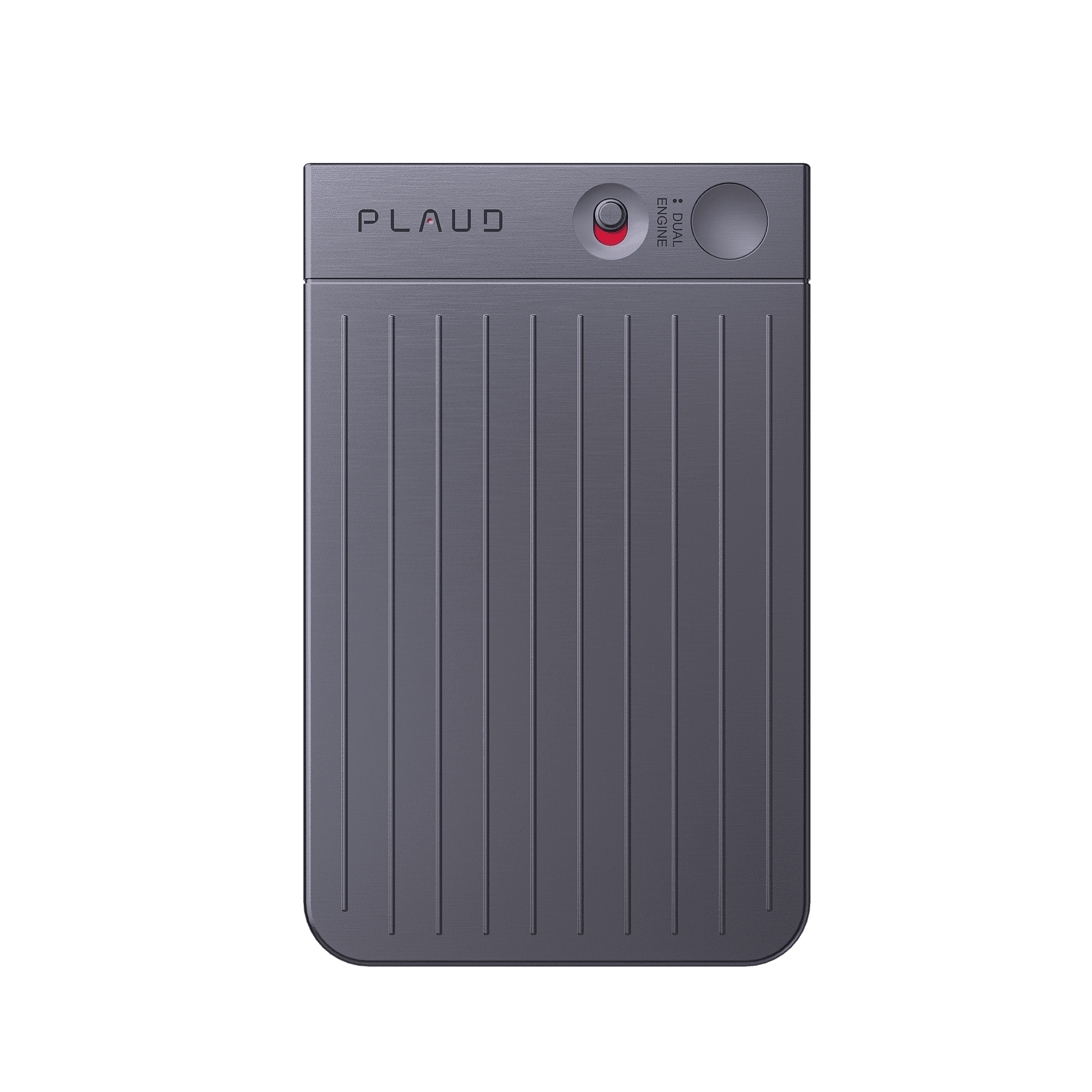Business meetings are a way in which individuals discuss how they will collaborate to achieve a specific goal. Whether it's a team meeting, a one-on-one meeting, or even just a small family meeting, it is essential when trying to make decisions.
Many companies struggle to grow due to a lack of business meetings that provide a clear goal and structure. A successful business typically ensures that all necessary elements are in place, including a well-defined structure, clear objectives, thorough preparation, and efficient note-taking that highlights its contributions to achieving the goal.
Business meetings should generally utilize note-taking tools like Plaud Note to help speed up the process by transcribing and documenting everything said during the meeting. That is why, in this guide, we will discuss the steps to run a successful business meeting. We will also discuss why tools like Plaud Note and Plaud NotePin are the best options for any meeting, helping you make informed decisions. Let's dive in.
Why are business meetings important?
Business meetings will always remain the most important part of business communication. They provide space for decision-making, brainstorming, accountability, and collaboration. Generally, meetings are where strategies are developed, disagreements are clarified, and opportunities are identified.
Businesses operate globally in hybrid environments nowadays. Meetings have become the core strategy that keeps dispersed teams together. Without meetings, information clusters will spread, execution will be delayed, and accountability will disappear.
10 steps to run effective business meetings
A key point to note is that Plaud Note simplifies preparation, delivery, and follow-up. Its speech-to-text transcription will capture every word spoken during the meeting and translate it into multiple languages, if needed, to ensure teams never worry about misplaced information. This AI assistance constructs reusable agendas, creates follow-up emails, and turns each conversation into actions.
1. Define the meeting objective
Every meeting should start with a clear objective. Is it to decide, plan, brainstorm, or review progress? Defining the objective helps avoid misunderstandings and clarifies for everyone what is to come.
A clear objective keeps everyone focused and ensures that decisions are made within the given timeframe. Without it, meetings may get out of hand.
2. Craft the meeting agenda
An agenda is the blueprint of a meeting. It determines the sequence of topics, time spent, and presenters. Plaud's templates enable leaders to accomplish this faster. Leaders can start with a generic format or develop a custom one once and reuse it each time. Standard agendas conserve time and ensure everyone has clear expectations.
Example:
Meeting Title: Gum Marketing Strategy Meeting
Date/Time: March 10, 2025, 2:00 PM – 3:00 PM
Objective: Finalize marketing plan for product launch
Agenda Items:
1. Welcome and objective review – 5 min
2. Campaign performance recap – 10 min
3. Budget allocation discussion – 15 min
4. Launch timeline approval – 20 min
5. Action items and next steps – 10 min
3. Select the appropriate meeting attendees
Too many attendees scatter focus, and too few create blind spots. Select attendees based on their decision-making and subject matter relevance. This renders time and resource allocation efficient.
4. Send the meeting invitation email
Put the agenda, date/time, attendees, and pre-work into the invitation. Keep subject lines short, like "Project Alpha Status Wed 2 PM." Send it early so participants can prepare and scheduling conflicts are reduced.
5. Stick to the meeting agenda
Your guide should be the meeting's agenda during the meeting. Designate a timekeeper to keep sessions on track and return discussions to track if they stray off course.
6. Take accurate meeting notes
You need to take decent, accurate notes for accountability reasons, but the traditional note-taking method is often cumbersome and prone to errors. All that stress can be utilised with the speech-to-text transcription offered by Plaud Note. It automatically labels information about who said what. It also supports 112 languages to cater to international teams and is technologically precise in recording industry-specific slang.

When everything is complete, a searchable transcript will be available, allowing for easy review, summarization, and follow-up without concern for missing information.
7. Develop a strategy to deliver on your action points
Follow-up meetings are lost opportunities. Assignments of designated owners, timelines, and desired outcomes for each action item.
8. Use a post-meeting communication method
Aside from meeting minutes, teams need a reproducible stream to exchange outcomes. Options include Slack summaries, joint Google Docs, or task management software.
9. Send a follow-up email
A follow-up email solidifies commitments. Instead of typing it out from scratch, teams can open the Plaud transcript, choose Ask AI, and ask: "Create a follow-up email with decisions, action items, owners, and deadlines." The AI generates a formatted email that can be edited to suit the tone.
Sample follow-up email:
Subject: Follow-Up – Gum Marketing Strategy Meeting
Dear Team,
Thank you for attending today’s meeting. Below is a summary of key decisions and action items:
Decisions:
- Approved $50,000 ad budget allocation.
- Launch timeline set for May 15, 2025.
Action Items:
- Sarah: Finalize vendor contracts by March 20.
- David: Draft creative assets by March 25.
- Priya: Prepare launch dashboard by April 1.
Next Meeting: April 5, 2025, to review readiness.
Best regards,
[Achaki]
10. Request feedback
Close the loop by asking participants whether the meeting went well. Feedback on structure, clarity, and tools used improves subsequent sessions.
Ground rules for great meetings
- Stay on point and focus on conversations.
- Assign a facilitator to the discussion.
- Be respectful of time limits.
- Capture and agree on key conclusions before closure.
- Take action with clear follow-ups and accountability.
8 types of business meetings
1. Formal meetings
They should be structured, driven by the agenda, and should be held mainly by external stakeholders. These meetings need a detailed record and should adhere to protocol
2. Informal meetings
These meetings should sync quickly. They should be flexible and have minimal preparation. Most useful for rapid problem-solving.
3. Decision-making meetings
The primary focus here is on decision-making regarding approval. Plaud’s speaker labels ensure decisions are attributed clearly, reducing confusion later.

4. Planning meetings
Used to set timelines, resources, and responsibilities for projects. These sessions align teams on priorities.
5. Project status/update meetings
Regular updates on progress and blockers. Instead of recurring calls, teams can use Plaud’s AutoFlow to record quick async updates, and Plaud transcribes and distributes summaries to email or Slack automatically.
6. Innovation meetings
Brainstorming sessions where creativity flows. Plaud captures every idea verbatim, so none are lost in the energy of fast discussions.
7. Team-building meetings
Sessions are designed to strengthen relationships. Focus on collaboration, trust, and morale.
8. Problem-solving meetings
Dedicated to identifying root causes and exploring solutions. Require clear documentation so outcomes are actionable.
Start having successful business meetings with Plaud!
Having productive business meetings is no longer a matter of lengthy and tiring preparation and note-taking. With structured agendas, clear objectives, and tools like Plaud Note, groups and individuals can capture ideas, track progress, and follow up with ease.

By following these steps, organizations can make their 2025 meetings productive, accountable, and action-focused.
Key takeaways
- A successful meeting starts with clear objectives and a structured agenda.
- Plaud Note streamlines agendas, captures multilingual notes, and automates follow-ups.
- Limiting participants and sticking to time limits boosts efficiency.
- Accurate notes and AI-generated follow-up emails improve accountability.
- Continuous feedback ensures that meetings evolve to meet the team's needs.
Conclusion
Business meetings are essential for effective organizational planning and informed decision-making. In 2025, effective meetings depend on preparation, design, and technology. By setting measurable goals, inviting only necessary participants, and having a clear agenda, teams can ensure that every meeting adds value.
A successful meeting is defined by the clarity and speed of its outcomes, not its duration. With hybrid best practices and AI support, businesses can turn meetings into engines of alignment, innovation, and measurable results.
FAQs
Can I record a meeting, and how do we handle consent and privacy?
Yes, but never jeopardize your company's privacy policies. Alert participants before recording, obtain explicit consent where necessary, and keep transcripts safe.
When do I cancel a meeting and replace it with an async update?
If it's an information-only meeting with no decisions to be made, turn to an asynchronous update. Plaud AutoFlow can distribute concise summaries to the team inboxes without filling calendars.
How do I calculate the cost of a meeting to determine who really needs to attend?
Take the average hourly rate of participants and multiply it by the meeting's duration. That reveals the budgetary cost of each meeting and helps you determine who needs to attend.
What are the elements of a successful follow-up email after a meeting?
It should include decisions outlined, action items allocated, and deadlines attached. Plaud's Ask AI can automatically make formal follow-ups from transcripts.
How can global teams have effective meetings in different languages?
Plaud transcribes 112 languages with speaker labeling, enabling global teams to work efficiently and review conversations accurately.





